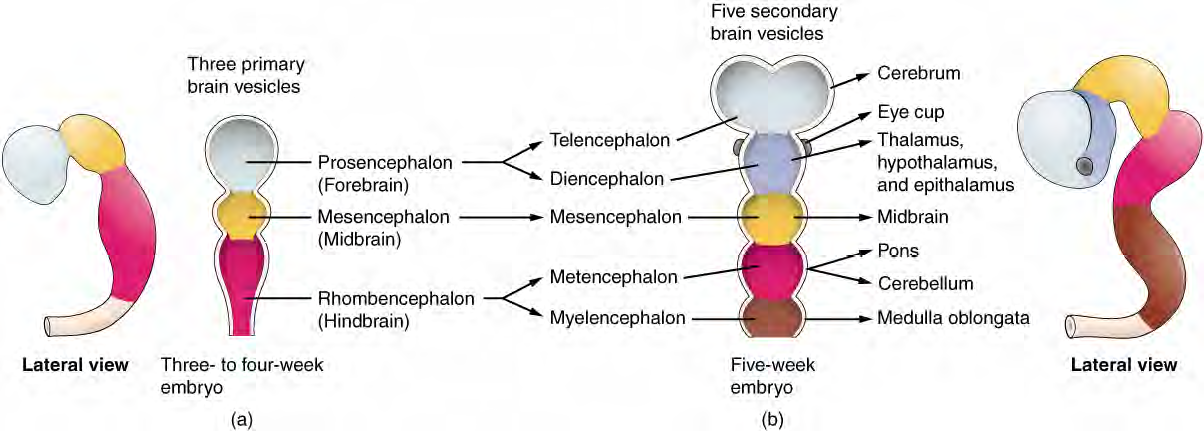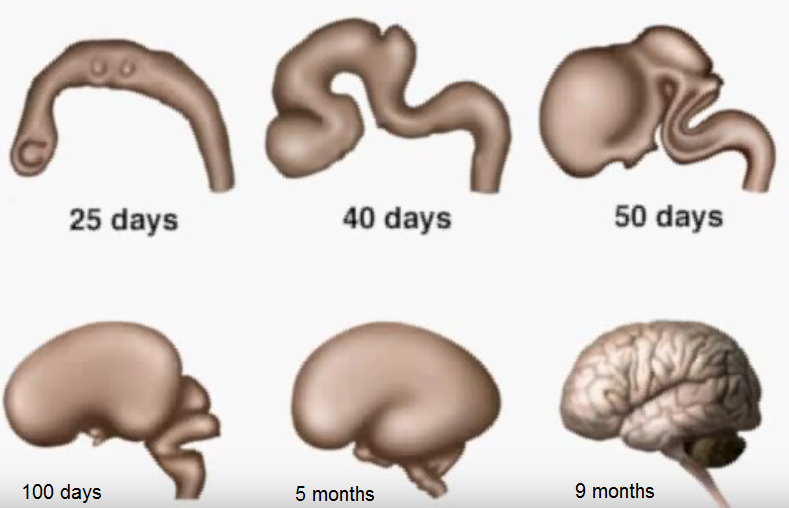The brain develops from the ectoderm layer of the growing embryo and forms a neural tube. Before neural tube is complete, the cephalic portion starts to grow faster. This enlarged portion starts to grow into three vesicles: the prosencephalon (prō-zen-SEF-a-lon), or forebrain (pro- means "before," but also think of a "pro" athlete always in the front); the mesencephalon, or midbrain; and the rhombencephalon (rom-ben-SEF-a-lon), or hindbrain (think of the "rump" or your backend to remember the hindbrain). Except for the midbrain, or mesencephalon, the vesicles will divide into more vesicles and then into the parts of the brain during development. The "pros" becomes the cerebrum and diencephalon (the forefront of our thinking and homeostasis), the "mes" remains the midbrain, and the "rhomb" becomes the inferior and posterior portions of the brain stem and cerebellum (Figure 2).

Figure 2. Development of the Brain includes three primary brain vesicles, the Prosencephalon (forebrain), Mesencephalon (midbrain), Rhombencephalon (hindbrain). These develop into the primary parts of the brain - Cerebrum, Diencephalon, Midbrain, Pons, Cerebellum, and the Medulla oblongata.
The early nervous system is a simple hollow tube that runs from the anterior end of the embryo to the posterior end. Beginning at 25 days, the anterior end develops into the brain, and the posterior portion becomes the spinal cord. This is the most basic arrangement of tissue in the nervous system, and it gives rise to the more complex structures by the fourth week of development.

Figure 3. Human Fetal Brain Development Milestones at 25 days, 40 days, 50 days, 100 days, 5 months and 9 months.
We can see various connections within the embryonic brain when we later examine the special senses. For instance, the retina, which began as part of the diencephalon, is primarily connected to the diencephalon. The eyes are just inferior to the anterior-most part of the cerebrum, but the optic nerve extends back to the thalamus as the optic tract, with branches into a region of the hypothalamus. There is also a connection of the optic tract to the midbrain, but the mesencephalon is adjacent to the diencephalon, so that is not difficult to imagine.
We know that the brain develops over childhood through adulthood. If the brain (especially the prefrontal cortex) does not finish developing until approximately 20 years of age, can teenagers be held responsible for behaving badly? Read on about the anatomy of the brain, recalling its development as you go.


